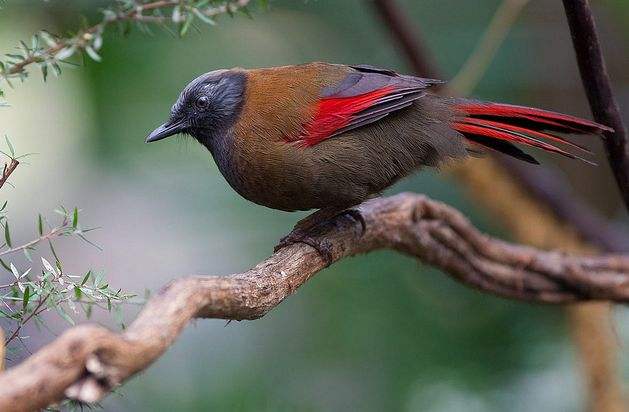Garrulax formosus
IUCN
LCBasic Information
Scientific classification
- name:Garrulax formosus
- Scientific Name:Garrulax formosus,Red-winged Laughingthrush
- Outline:Songbird
- Family:Passeriformes Thrushidae Laughingthrush
Vital signs
- length:20-28cm
- Weight:57-95g
- lifetime:No verification information
Feature
The head is gray olive brown with thick black vertical stripes, the wings have large bright red spots, and the tail is also bright red.
Distribution and Habitat
Distributed in Pingshan, Emei, Wenchuan, Ganluo, Mabian, Ebian, Tianquan, Baoxing, Pengxian, Kangding, Dujiangyan in Sichuan, China, Yanjin, Suijiang, Yongshan, Daguan in Yunnan and Guangxi. Western part of Tonkin Bay in northern Vietnam.
It mainly inhabits the ground or near the ground in dense evergreen broad-leaved forests, mixed coniferous and broad-leaved forests, secondary forests and bamboo forests in mountains at an altitude of 1400-2600 meters.
Appearance
The male and female red-winged babblers have similar plumage colors. The forehead and top of the head are grayish brown or grayish olive brown, and the center of each feather is black, forming a thick black central vertical stripe and a gray feather edge; the front of the eyes, cheeks, face, eyebrow lines, and side of the head are black, and the ear feathers are silvery gray or grayish white, with Black shaft pattern; nape, upper back, brown or ocher chestnut, waist and tail coverts brown or olive brown. The central tail feathers are dark red or purple, and the outer edges are bright red. The inner feathers of the outer tail feathers are reddish brown or dark brown, and the outer feathers are bright red or dark red. The primary coverts are bright red, and the rest of the coverts are the same as the back; the flight feathers are dark brown, with a broad bright red edge on the outer leaflet. The bright red feathery edge gradually expands to the entire outer leaflet farther inward, and on
Details
Red-winged Laughingthrush has two subspecies.

Red-winged Laughingthrush often moves in pairs or small groups of several individuals, often shuttling and jumping between the undergrowth, and also frequently moving and foraging on the ground under the forest. It mainly feeds on insects and plant foods. Among the foods it eats, animal foods mainly include ladybugs, beetles, coleoptera insects, centipedes and snails, and plant foods mainly include fruits and seeds of roses, ivy, Zanthoxylum, honeysuckle and legumes.
The breeding season of the red-winged laughingthrush is from May to July. The nest is mainly made of moss and bamboo leaves, and is padded with palm fibers and other materials. The size of the nest is 7.2 cm in inner diameter and 5.2 cm in depth. The eggs are green with black fine lines. The size of the eggs is 2.1 cm × 1.87 cm and weighs 3.9 grams.
The distribution area of the red-winged laughingthrush is narrow and the population is scarce. In particular, due to its colorful feathers and good singing, the Red-winged Laughing Thrush is deeply loved by people and is often captured and raised as a caged ornamental bird, resulting in a decreasing population.
Listed in the 2012 Red List of Endangered Species of the World Conservation Union (IUCN) ver 3.1 - Least Concern (LC).
Listed in the second level of the List of National Key Protected Wildlife in China.
Protect wild animals and eliminate game.
Maintaining ecological balance is everyone's responsibility!








